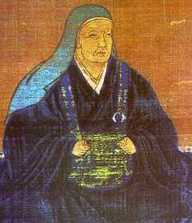 Imagawa Jukeini
Imagawa Jukeini Owada Tetsuo, Sengoku no Gunzō (A Mass Portrait of the Era of the Warring States), Gakken Shinsho, Tokyo, 2009
Chapter 6 The major role played by women
`The appearance of female daimyō` and `female jitō`
Female Daimyō – the case of Imagawa Jukeini (寿桂尼)
I have considered writing a chapter about women in this book, which takes as its theme the various people of the Sengoku era. When considering the chaotic world of the Sengoku era, there has been a tendency to have preconceptions of men fighting on the battlefield, while women are regarded as `a protector after the guns cease firing`, with their presence both beginning and ending with them in a supporting role. For the women of the Middle Ages period who lived in a society of warriors, particularly from the Muromachi era onwards, it became more common for them to live a more cloistered life, whereby they would be married off and as wives be relegated to a less-prominent position in the household dominated by the male patriarch. She would then be expected to adhere to the `lessons of the three stages of life`, which meant that as a child she would obey her father, after she was married she would obey her husband, and then as an old woman she would obey her son.(pg.208)
While there were many such women during that era, when we look more closely at the women of the Sengoku period, there appear women who strapped on their husband`s armour in order to fight in battle, and women who desperately defended their family`s castle in place of their still infant male children. Hence one particular characteristic of this period is the appearance of such women who could be called `female lords`, or female daimyō. One such woman who could be described as thus was Imagawa Jukeini. Allow me to go into a little more detail about her. (pg.209)
As we can tell from her name, Imagawa Jukeini was the wife of Sengoku daimyō Imagawa Ujichika, a lord of two provinces – Suruga and Tōtōmi. The Imagawa family were renowned for their affinity for the arts and held strong relations with Kyoto. Hence Ujichika`s wife was sent from the aristocratic Nakamikado family of Kyoto, the daughter of Nakamikado Nobutane. However we do not know what her name was (Jukeini was the name she adopted after taking vows following her husband`s death). Ujichika was at the time engaged in land surveying and quantification, and it was he who created the `Imagawa Kana Mokuroku`, a detailed work on the laws governing the Imagawa lands. It was Ujichika who elevated the Imagawa family from their previous position as shugo daimyō into the ranks of the Sengoku daimyō.(pg.209)
However, in the sixth year of Taiei (1526), Ujichika passed away. Ujichika had six sons, but because he had married relatively late, his eldest son Ujiteru was still only a youth of 14 years. There are examples of 14 year old youths taking on the reins of government, inheriting the position as head of the household and doing quite an admirable job. However Ujiteru was not only young, he was also sickly. In such times as these, what would usually occur would be that one of the senior levels of retainers would take on the role of an advisor to their young charge. However in the case of Ujiteru, Ujichika`s widow took on the name of Jukeini and became his advisor. She also happened to be Ujitane`s mother.(pg.209-210)
So how did Jukeini come to occupy a position that would normally be held by a man? There are no records that detail how this situation came about, so we must deduce its origins from the situation that existed at the time. The most commonly believed reason was that ten years before he died, Ujichika was stricken by disease which kept him confined to his private quarters. While nursing her husband, Jukeini also began to take responsibility for the political dealings of the household. The retainers of the household also believed that `in the same manner while Ujichika was still alive, Jukeini became an advisor to Ujiteru`.(210)
Two years after Ujichika`s death, a seal bearing the mark of Jukeini began to appear on public documents released by the Imagawa household. Until Ujiteru began issuing documents from the eighth year of Taiei onwards, Jukeini was head of the household. It is for this reason that scholars of the Sengoku period have come to generally use the term `female daimyō` to refer to such women.(pg.210)
In much the same way, the daughter of Hosokawa Katsumoto was married to Akamatsu Masanori, the lord of three provinces of Harima, Bizen, and Mimasaka. She was referred to a `Madam Meshi`, and after her husband`s death, she too issued documents instead of her son Yoshimura and then her grandson Saishōmaru. In much the same manner as Imagawa Jukeini, after her husband`s death this woman also took her vows and became known as Akamatsu Tōshōinni.(pg.211-212)
 RSS Feed
RSS Feed